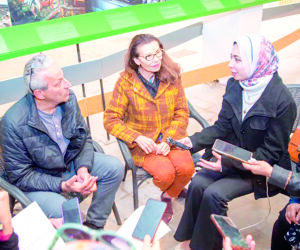American photojournalist Maggie Steber would have been among the dead, but for her dress.
She was in Haiti a few years ago, photographing a priest in a church, when 40 gunmen, who also had machetes, stormed the place and began killing the people inside.
Steber was in the first line, trying to get the best angle for her photos.
When the shooting started, like other people, she scrambled for hiding.
She was, however, caught by one of the attackers.
“The attacker lost his grip on my shoulder, but he still had it on my dress,” Steber said, apparently shaken by the memory. “He ripped it, and I think that was why he let me go.”
Steber photographed that dress. Photos telling thrilling stories like this one are participating in the Cairo Photo Week (CPW), a major meeting point of local and international photographers that kicked off in Cairo last week.

Other participants are bringing in photographs that have wonderful stories, sometimes of pain, behind them.
The week contains a wide range of activities, including exhibitions that parade the participating photographers’ most important works. It also contains a series of workshops where budding photographers and photography beginners get tips on how to hone their skills.
Steber is a photographic documentation guru. She spoke during some of the workshops of the event about a wide range of issues, most importantly climate change.
She worked in 64 countries, focusing on humanitarian, cultural, and social issues.
In attending the workshops, she is always keen on listening to photographers’ take on climate change and its impact on Earth.
She could not hold back her tears when an Egyptian boy showed her a photograph showing the River Nile in distress.
Ed Kashi, another American photographer, also participated in the CPW with his works, especially in the Climate Change Exhibition.
Apart from being a renowned photojournalist, Kashi is a filmmaker, a speaker, and an educator dedicated to documenting the social and geopolitical issues that define our times.
“Photographers sometimes see their colleagues lose their lives in front of their eyes,” Kashi told the Egyptian Mail.
He expressed admiration of Egyptian photographers for keeping their culture in mind while working.
This, he said, is what distinguishes them from others.
“Photos always reflect the way the people snapping them think,” Kashi said. “They always tell of what touches their heart to tell the perfect story.”
He and Steber are living examples of the critical situations photographers sometimes find themselves in.
Steber narrowly escaped death on the day of the church attack. Other people, however, could not make it to the exit door.
She said she is happy to be in Cairo for the CPW.
“I have been to many photo festivals, and for me, this is the most intimate and generous festival,” Steber said. “It is open, very accessible, and easy to reach.”
She expressed admiration of Egyptian photographers who recorded Egypt’s history.
She especially praised iconic photojournalist, Farouk Ibrahim.
“I really like the way he photographed movie stars,” Steber said. “He inspired me to think in a different way.”






Discussion about this post